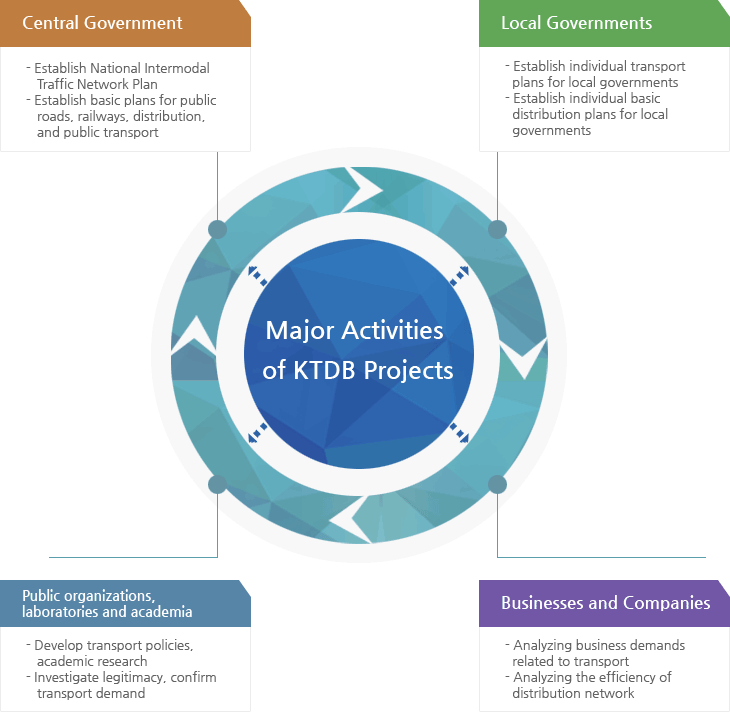About KTDB
 About KTDB
About KTDB
Major Usage of KTDB

Legal Application to Government Transport Plans
Use for various major plans, such as National Intermodal Traffic Network Plan, Mid-term Transport Infrastructure Investment Plan, Complex Transit Center Development Plan, and Intelligent Transport System Development Plan
Application to Demand Forecast of Individual Transport SOC Projects
Application to Feasibility Assessments of Government's Individual SOC
- Based on Articles 17 and 18 of the National Transport System Efficiency Act
- Comparison of Transport Infrastructure Investment Assessment System and Preliminary Feasibility System
- Used in 235 feasibility assessment projects by 2010
| Classification | Transport Infrastructure Investment Assessment System |
Preliminary Feasibility System |
|---|---|---|
| Ministry | Ministry of Land, Infrastructure and Transport | Ministry of Strategy and Finance |
| Applicable Act | National Transport System Efficiency Act | National Finance Act |
| Purpose |
|
Financial operation (i.e. efficient budget planning) |
| Time of application |
|
Budget planning stage |
| Evaluation subjects | Investment projects over 30 billion won | Investment projects of over 50 billion won |
| Level of analysis | Comprehensive and specialized in-depth analysis using transport planning models | Preliminary legitimacy analysis |
| Transport demand analysis | KTDB | KTDB |
| Assessment methods |
|
|
| Rating agencies |
|
Korea Development Institute |
Application in Establishing Government Special Transport Measures
Special Transport Measures for Holidays, including New Year’s Day, Summer Vacation, and Thanksgiving (Chuseok)
Based on Articles 17 and 18 of the National Transport System Efficiency Act

2015 Thanksgiving Day Special Transport Measures
- Passenger Ratio by Departure Date and Time (Estimate)
- Passenger Ratio by Departure Date and Time (Estimate)
Transport Measures during Big Events, such as Nuclear Security Summit or G-20 Summit
Developing transport measures with special investigation for the 2010 G-20 Summit and 2012 Nuclear Security Summit
Application to Transport Demand Management Policy
- Monitoring the effects of 5-day and 2-day rotation system of vehicles
- Monitoring changes in vehicle use demand according to fuel price changes
- Monitoring changes in transport demands during special events and the Golden Week in May
- Estimation of acceptable transport demands on the network
- Unique causes and management of transport that exceeds the network capacity
- Monitoring congestion levels (change of demand) according to policy changes, such as parking policy
Application to Government’s Trip Generation Charge Policy
Improving trip generation coefficient to enhance policy effectiveness according to 2014 revision of the trip generation unit share
- Studying methods to assess trip generation factors using the results of the trip generation unit investigation
- Improving research methods and calculation standards of trip generation, and promoting revision of trip generation coefficient

Comparison of Trip Generation Units of 5 Major Service Facilities (based on weekdays and weekends)
Application to Government's Sustainable Cities and Sustainable Transport Policies
Main indexes used: National and local greenhouse gas emissions, public transport distribution ratio of nation/cities/provinces/local governments, and transport records
Investigation of public transport use
Quarterly transport record and distribution ratio (including walking and riding bicycles) for the entire country and major cities
Relevant Legal Grounds
- Guidelines for Assessment of City's Sustainability based on Article 3 of National Land Planning and Utilization Act
- Sustainability assessment of local government’s transport and distribution systems based on Article 15 of Sustainable Transport and Distribution Act
Application to Government Public Transport Policy
Investigating interregional public transport service demands and supplies
- Driving path and frequency by route and service type
- Use of GIS Map Book

Analyzing the number of routes

Analyzing the frequency of standard buses



